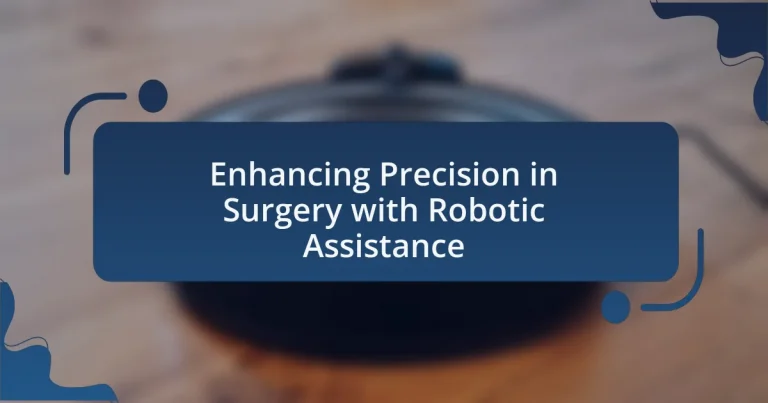Robotic assistance in surgery refers to the integration of robotic systems, such as the da Vinci Surgical System, to enhance surgical precision and control during procedures. This technology facilitates minimally invasive techniques, resulting in reduced recovery times, less postoperative pain, and improved surgical outcomes, including fewer complications and shorter hospital stays. Key technologies involved in robotic surgical systems include robotic arms, advanced imaging systems, and haptic feedback mechanisms, which collectively enhance visualization and dexterity. Various surgical specialties, particularly urology, gynecology, and general surgery, benefit significantly from robotic assistance, leading to better patient outcomes and operational efficiencies. However, challenges such as high costs, technical complexity, and the need for specialized training remain barriers to widespread adoption.

What is Robotic Assistance in Surgery?
Robotic assistance in surgery refers to the use of robotic systems to aid surgeons in performing surgical procedures with enhanced precision and control. These robotic systems, such as the da Vinci Surgical System, allow for minimally invasive techniques, which can lead to reduced recovery times and less postoperative pain for patients. Studies have shown that robotic-assisted surgeries can improve surgical outcomes, with a report indicating that these procedures often result in fewer complications and shorter hospital stays compared to traditional methods.
How does robotic assistance enhance surgical precision?
Robotic assistance enhances surgical precision by providing surgeons with advanced tools that improve accuracy and control during procedures. These robotic systems, such as the da Vinci Surgical System, utilize high-definition 3D visualization and articulated instruments that can maneuver in tight spaces, allowing for more precise movements than the human hand. Studies have shown that surgeries performed with robotic assistance result in reduced blood loss, shorter recovery times, and fewer complications, demonstrating the effectiveness of robotic technology in enhancing surgical outcomes.
What technologies are involved in robotic surgical systems?
Robotic surgical systems involve several key technologies, including robotic arms, advanced imaging systems, and haptic feedback mechanisms. Robotic arms provide precision and dexterity, allowing surgeons to perform complex procedures with enhanced control. Advanced imaging systems, such as 3D visualization and intraoperative imaging, facilitate real-time guidance during surgery. Haptic feedback mechanisms enable surgeons to feel the tissue resistance, improving their tactile perception during minimally invasive procedures. These technologies collectively enhance surgical precision, reduce recovery times, and improve patient outcomes, as evidenced by studies showing lower complication rates in robotic-assisted surgeries compared to traditional methods.
How do robotic systems improve visualization during surgery?
Robotic systems improve visualization during surgery by providing high-definition, 3D imaging that enhances the surgeon’s ability to see intricate anatomical structures. These systems often incorporate advanced camera technology that offers magnification and improved depth perception, allowing for more precise navigation and manipulation of tissues. For instance, the da Vinci Surgical System utilizes a 3D HD camera that provides a clearer view of the surgical field compared to traditional laparoscopic techniques, which typically use 2D imaging. This enhanced visualization contributes to reduced complications and improved surgical outcomes, as evidenced by studies showing lower rates of conversion to open surgery and shorter recovery times in robotic-assisted procedures.
What types of surgeries benefit from robotic assistance?
Robotic assistance benefits various types of surgeries, including urologic, gynecologic, thoracic, and orthopedic procedures. In urologic surgeries, such as prostatectomies, robotic systems enhance precision and reduce recovery time. Gynecologic surgeries, like hysterectomies, also see improved outcomes with robotic assistance, allowing for minimally invasive techniques. Thoracic surgeries, including lung resections, benefit from the enhanced visualization and dexterity provided by robotic tools. Additionally, orthopedic surgeries, such as knee and hip replacements, utilize robotic systems to improve alignment and accuracy, leading to better patient outcomes. These advancements are supported by numerous studies demonstrating reduced complications and faster recovery times associated with robotic-assisted surgeries.
Which surgical specialties are most impacted by robotic assistance?
Robotic assistance most significantly impacts surgical specialties such as urology, gynecology, and general surgery. In urology, robotic systems enhance precision in procedures like prostatectomies, leading to reduced recovery times and improved outcomes. Gynecological surgeries, particularly hysterectomies, benefit from robotic assistance by minimizing invasiveness and optimizing surgical accuracy. General surgery also sees advancements through robotic techniques, particularly in complex procedures like bariatric surgery, where enhanced visualization and dexterity are crucial. These specialties have adopted robotic systems extensively, demonstrating improved patient outcomes and operational efficiencies.
How does robotic assistance compare to traditional surgical methods?
Robotic assistance offers greater precision and control compared to traditional surgical methods. Studies indicate that robotic-assisted surgeries result in reduced blood loss, shorter recovery times, and less postoperative pain. For instance, a meta-analysis published in the Journal of Robotic Surgery found that patients undergoing robotic-assisted prostatectomy experienced a 50% reduction in blood loss compared to those who had open surgery. Additionally, robotic systems provide enhanced visualization and dexterity, allowing surgeons to perform complex procedures with improved accuracy.

What are the key advantages of using robotic assistance in surgery?
The key advantages of using robotic assistance in surgery include enhanced precision, reduced recovery time, and minimized invasiveness. Robotic systems, such as the da Vinci Surgical System, allow surgeons to perform complex procedures with greater accuracy due to their ability to scale movements and provide a 3D view of the surgical site. Studies have shown that robotic-assisted surgeries can lead to less blood loss and lower complication rates, which contribute to faster patient recovery. For instance, a review published in the Journal of Robotic Surgery indicated that patients undergoing robotic-assisted prostatectomy experienced shorter hospital stays and quicker return to normal activities compared to traditional methods.
How does robotic assistance reduce surgical complications?
Robotic assistance reduces surgical complications by enhancing precision and control during procedures. The use of robotic systems allows surgeons to perform minimally invasive techniques with greater accuracy, which leads to reduced tissue damage and shorter recovery times. Studies have shown that robotic-assisted surgeries result in lower rates of complications such as infections, bleeding, and longer hospital stays compared to traditional methods. For instance, a meta-analysis published in the Journal of Robotic Surgery found that robotic-assisted prostatectomies had a significantly lower complication rate than open surgeries, demonstrating the effectiveness of robotic assistance in improving surgical outcomes.
What role does precision play in minimizing patient recovery time?
Precision significantly reduces patient recovery time by ensuring accurate surgical interventions, which minimizes tissue damage and promotes faster healing. When surgeries are performed with high precision, such as through robotic assistance, the risk of complications decreases, leading to shorter hospital stays and quicker return to normal activities. Studies have shown that minimally invasive procedures, characterized by precision, can reduce recovery time by up to 50% compared to traditional methods, as they involve smaller incisions and less trauma to surrounding tissues. This evidence underscores the critical role of precision in enhancing surgical outcomes and expediting patient recovery.
How does robotic assistance enhance surgeon ergonomics?
Robotic assistance enhances surgeon ergonomics by providing improved posture and reducing physical strain during procedures. The robotic systems allow surgeons to operate from a seated position, which minimizes fatigue and discomfort associated with standing for extended periods. Additionally, robotic arms can perform precise movements with minimal effort from the surgeon, reducing the risk of repetitive strain injuries. Studies have shown that surgeons using robotic systems report lower levels of physical discomfort and fatigue compared to traditional surgical methods, thereby supporting the claim that robotic assistance significantly improves ergonomic conditions in the operating room.
What are the economic implications of robotic-assisted surgeries?
Robotic-assisted surgeries have significant economic implications, primarily through cost savings, improved patient outcomes, and increased operational efficiency. These surgeries often result in shorter hospital stays, which can reduce overall healthcare costs; for instance, a study published in the Journal of Robotic Surgery found that robotic procedures can lower hospital costs by approximately 20% compared to traditional methods. Additionally, enhanced precision leads to fewer complications and readmissions, further decreasing long-term healthcare expenses. The initial investment in robotic systems can be offset by these savings, as hospitals may experience increased patient throughput and higher revenue from advanced surgical offerings.
How do robotic systems affect hospital costs and patient billing?
Robotic systems significantly reduce hospital costs and improve patient billing efficiency by minimizing complications and shortening recovery times. Studies indicate that robotic-assisted surgeries often lead to fewer postoperative complications, which can decrease the length of hospital stays and associated costs. For instance, a study published in the Journal of Robotic Surgery found that robotic procedures resulted in a 20% reduction in hospital readmission rates compared to traditional methods. Additionally, the precision of robotic systems can lead to more accurate billing, as fewer resources are required for follow-up care and complications, ultimately streamlining the billing process for hospitals.
What is the return on investment for hospitals using robotic systems?
The return on investment for hospitals using robotic systems is typically positive, with studies indicating that robotic-assisted surgeries can lead to cost savings and improved patient outcomes. For instance, a study published in the Journal of Robotic Surgery found that hospitals utilizing robotic systems experienced a reduction in hospital stay duration by approximately 1.5 days, which translates to significant savings in operational costs. Additionally, robotic systems can enhance surgical precision, leading to fewer complications and readmissions, further contributing to financial benefits. Overall, the integration of robotic systems in surgical procedures has been shown to yield a favorable return on investment through both direct cost savings and improved clinical outcomes.

What challenges are associated with robotic assistance in surgery?
Robotic assistance in surgery faces several challenges, including high costs, technical complexity, and the need for specialized training. The high costs associated with robotic surgical systems can limit access for many healthcare facilities, as initial investments and maintenance expenses are significant. Technical complexity arises from the sophisticated nature of robotic systems, which can lead to operational difficulties during procedures. Additionally, surgeons require extensive training to effectively use robotic systems, which can be time-consuming and may not be readily available. These challenges can hinder the widespread adoption and effectiveness of robotic assistance in surgical settings.
What are the limitations of current robotic surgical systems?
Current robotic surgical systems have several limitations, including high costs, limited tactile feedback, and a steep learning curve for surgeons. The high costs of robotic systems can restrict access to advanced surgical techniques, as initial investments and maintenance expenses are significant. Limited tactile feedback means that surgeons may not have the same level of sensory input as with traditional methods, potentially affecting their ability to gauge tissue resistance and manipulate instruments effectively. Additionally, the steep learning curve can hinder the adoption of these systems, as surgeons require extensive training to operate them proficiently, which can delay the integration of robotic assistance in surgical practices.
How do technical malfunctions impact surgical outcomes?
Technical malfunctions significantly impair surgical outcomes by increasing the risk of complications, prolonging surgery duration, and potentially leading to patient harm. For instance, a study published in the Journal of Robotic Surgery found that robotic system failures during procedures resulted in a 30% increase in conversion to open surgery, which is associated with higher morbidity rates. Additionally, malfunctions can lead to incorrect instrument positioning, which may compromise the surgical site and affect the overall success of the operation. These factors underscore the critical importance of ensuring the reliability of robotic systems in surgical environments to optimize patient safety and surgical efficacy.
What training is required for surgeons to effectively use robotic systems?
Surgeons require specialized training in robotic systems that includes both theoretical knowledge and practical skills. This training typically encompasses understanding the robotic system’s mechanics, mastering the console operation, and gaining proficiency through simulation and hands-on practice in a controlled environment. Studies indicate that structured training programs, such as those offered by manufacturers like Intuitive Surgical for the da Vinci Surgical System, significantly enhance a surgeon’s ability to perform robotic-assisted procedures effectively. Furthermore, ongoing education and mentorship are crucial for maintaining proficiency and adapting to advancements in robotic technology.
How can hospitals overcome barriers to implementing robotic assistance?
Hospitals can overcome barriers to implementing robotic assistance by investing in comprehensive training programs for surgical staff and ensuring adequate financial resources for technology acquisition. Training programs enhance the proficiency of medical personnel in using robotic systems, which is crucial as studies indicate that skilled operators significantly improve surgical outcomes. Additionally, hospitals should explore partnerships with technology providers to facilitate funding options, as the initial costs of robotic systems can be substantial; for instance, the average cost of a robotic surgical system can exceed $2 million. By addressing these training and financial challenges, hospitals can effectively integrate robotic assistance into their surgical practices, leading to improved precision and patient outcomes.
What strategies can be employed to ensure successful integration of robotic systems?
Successful integration of robotic systems in surgery can be achieved through comprehensive training, interdisciplinary collaboration, and robust system testing. Comprehensive training ensures that surgical teams are proficient in operating robotic systems, which has been shown to improve surgical outcomes and reduce complications. Interdisciplinary collaboration among surgeons, engineers, and IT specialists fosters a better understanding of the robotic systems’ capabilities and limitations, leading to more effective utilization. Additionally, robust system testing prior to deployment helps identify potential issues and ensures that the robotic systems function correctly in a clinical environment, as evidenced by studies indicating that thorough pre-implementation testing reduces operational failures by up to 30%.
What best practices should be followed for successful robotic-assisted surgeries?
Successful robotic-assisted surgeries require adherence to several best practices, including thorough preoperative planning, comprehensive training for surgical teams, and effective communication among all participants. Preoperative planning involves detailed assessments of the patient’s condition and the surgical procedure, ensuring that the robotic system is appropriately configured for the specific case. Comprehensive training is essential, as studies indicate that surgeons with extensive experience in robotic systems achieve better outcomes, with a reported decrease in complication rates by up to 30%. Effective communication among the surgical team enhances coordination and minimizes errors during the procedure, which is critical given that robotic surgeries often involve multiple specialists. These practices collectively contribute to improved surgical precision and patient safety in robotic-assisted surgeries.





